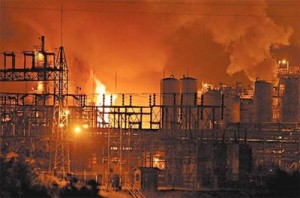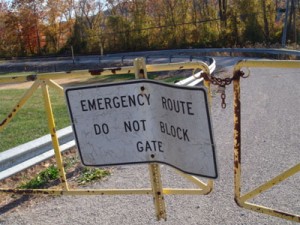04
Dec
25 Years After Plant Explosion Bhopal Residents Still Suffer
(Beyond Pesticides, December 4, 2009) Twenty-five years ago, a toxic cloud of gas from the Union Carbide plant in Bhopal, India, enveloped the surrounding city, leaving thousands dead. Anywhere between 50,000 to 90,000 lbs of the chemical methyl isocyanate (MIC) are estimated to have leaked into the air, killing approximately 8,000-10,000 people within the first three days, according to data by the Indian Council of Medical Research (ICMR). Advocacy groups working with victims say that more than 25,000 have died to date, and more than 120,000 people still suffer from severe health problems as a result of their exposure.
According to a Reuters piece on the anniversary of Bhopal, “India’s “death factory” leaves toxic legacy 25 years on,” there are still 40 metric tonnes of chemical waste stored in a warehouse inside the plant that still needs disposal. Dow Chemical, which now owns Union Carbide, denies any responsibility saying it bought the company a decade after Union Carbide had settled its liabilities to the Indian government in 1989 by paying $470 million for the victims.
“After the disaster, Union Carbide did this botched site remediation and created a massive landfill,” said Rajan Sharma, a New York-based lawyer demanding that Dow Chemical clean up the site and purify the water supply.
“There are thousands of tons of toxic chemical waste which have been not been properly disposed inside and just outside the factory site, which have been seeping into the ground for years,” Mr. Sharma said.
Delhi-based think-tank, the Center for Science and Environment (CSE), reports that samples taken around the factory site in Bhopal contain chlorinated benzene compounds and organochlorine pesticides 561 times the national standard. Samples taken as far as 1.9 miles away have toxic chemicals 38.6 times more than the standard. The report says that there could be no other source of these chemicals than Union Carbide.
Earlier this year, a U.S. District Court Judge denied a request for remediation in resolving the on-going lawsuit between the victims in Bhopal, India and Union Carbide, after Union Carbide objected to the victims’ request for remediation. Dow Chemical bought Union Carbide in 2001 and with it the liabilities for the chemical plant disaster involving the production of MIC which is an intermediate chemical used in the production of aldicarb, carbaryl, carbofuran, methomyl and other carbamate pesticides. Dow Chemical has refused to clean up the site, provide safe drinking water, compensate the victims, or disclose chemical information to physicians; claiming that the Indian government is responsible for the environmental cleanup.
After Bhopal, other plants around the world eliminated large-scale MIC storage. The Institute facility in West Virginia, which Bayer took over in 2001, is the only one in the U.S. that continued to store large amounts and remains the only one nationwide that trips a 10,000-pound threshold for the federal Environmental Protection Agency’s Risk Management Program, according to the Coalition against BAYER Dangers (CBG).
On the night of August 28, 2008, a pesticide waste tank containing MIC exploded at Bayer’s Institute, West Virginia plant. Two workers were killed, and the blast was heard in Mink Shoals, more than ten miles away. Despite individual accounts of the resulting air pollution, Bayer officials assured the public that no chemicals had escaped the plant; however an investigation of Bayer’s safety history and the area’s emergency response revealed a shaky safety record.
Congressional investigators reported in a hearing last April that debris from that explosion could have easily hit and damaged an MIC storage tank, causing a disaster that “could have eclipsed” Bhopal. The explosion was “potentially a serious near miss, the results of which might have been catastrophic for workers, responders and the public,” explains the federal Chemical Safety Board (CSB) Chairman John Bresland.
Bayer CropScience announced its plans to reduce the storage of MIC at Institute by 80 percent in August””one year after the Institute facility’s explosion. According to CBG, a board spokesman said this week that Bayer has briefed the CSB on the project, however the board did not answer other questions about how the work was progressing. The inventory reduction is purported to take about a year, cost $25 million and not result in any lost jobs at the Institute plant.
While this is a step in the right direction, many advocates point out that even if Bayer follows through with its 80% reduction promise, it would still allow up to 50,000 pounds of MIC to be stored on site.
Photo gallery:
West Virginia

August 2008 explosion at the Bayer CropScience plant in WV

Photo of the gate closing off the Institute community's evacuation route. By Maya Nye, 11/08
Bhopal

Bhopal plant control room. (Photo by Jay Feldman, Beyond Pesticides)

Bhopal procedures for an emergency. (Photo by Jay Feldman, Beyond Pesticides)










